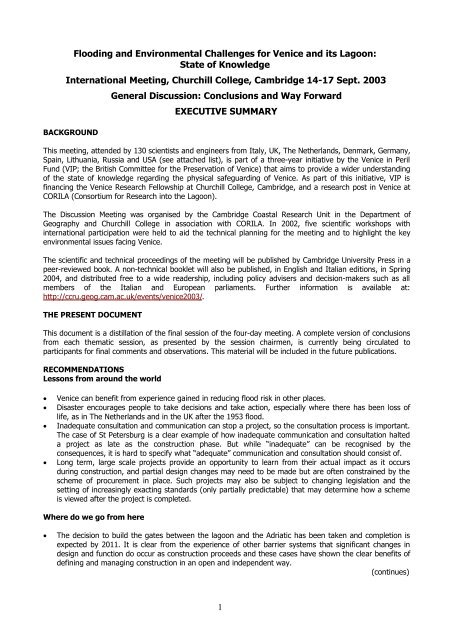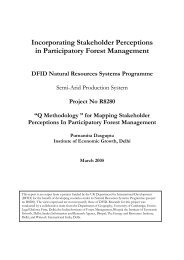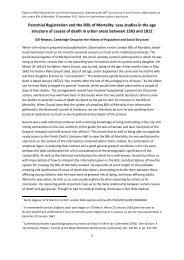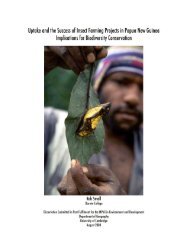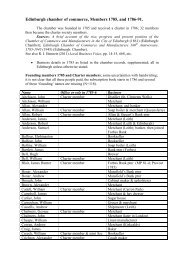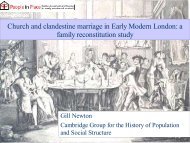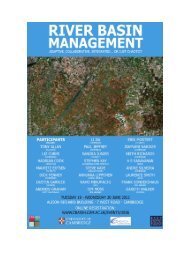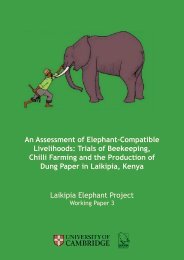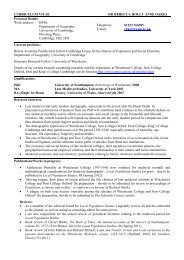Draft Conclusions: Cambridge Executive Summary (October 2003)
Draft Conclusions: Cambridge Executive Summary (October 2003)
Draft Conclusions: Cambridge Executive Summary (October 2003)
You also want an ePaper? Increase the reach of your titles
YUMPU automatically turns print PDFs into web optimized ePapers that Google loves.
Flooding and Environmental Challenges for Venice and its Lagoon:<br />
State of Knowledge<br />
International Meeting, Churchill College, <strong>Cambridge</strong> 14-17 Sept. <strong>2003</strong><br />
BACKGROUND<br />
General Discussion: <strong>Conclusions</strong> and Way Forward<br />
EXECUTIVE SUMMARY<br />
This meeting, attended by 130 scientists and engineers from Italy, UK, The Netherlands, Denmark, Germany,<br />
Spain, Lithuania, Russia and USA (see attached list), is part of a three-year initiative by the Venice in Peril<br />
Fund (VIP; the British Committee for the Preservation of Venice) that aims to provide a wider understanding<br />
of the state of knowledge regarding the physical safeguarding of Venice. As part of this initiative, VIP is<br />
financing the Venice Research Fellowship at Churchill College, <strong>Cambridge</strong>, and a research post in Venice at<br />
CORILA (Consortium for Research into the Lagoon).<br />
The Discussion Meeting was organised by the <strong>Cambridge</strong> Coastal Research Unit in the Department of<br />
Geography and Churchill College in association with CORILA. In 2002, five scientific workshops with<br />
international participation were held to aid the technical planning for the meeting and to highlight the key<br />
environmental issues facing Venice.<br />
The scientific and technical proceedings of the meeting will be published by <strong>Cambridge</strong> University Press in a<br />
peer-reviewed book. A non-technical booklet will also be published, in English and Italian editions, in Spring<br />
2004, and distributed free to a wide readership, including policy advisers and decision-makers such as all<br />
members of the Italian and European parliaments. Further information is available at:<br />
http://ccru.geog.cam.ac.uk/events/venice<strong>2003</strong>/.<br />
THE PRESENT DOCUMENT<br />
This document is a distillation of the final session of the four-day meeting. A complete version of conclusions<br />
from each thematic session, as presented by the session chairmen, is currently being circulated to<br />
participants for final comments and observations. This material will be included in the future publications.<br />
RECOMMENDATIONS<br />
Lessons from around the world<br />
<br />
<br />
<br />
<br />
Venice can benefit from experience gained in reducing flood risk in other places.<br />
Disaster encourages people to take decisions and take action, especially where there has been loss of<br />
life, as in The Netherlands and in the UK after the 1953 flood.<br />
Inadequate consultation and communication can stop a project, so the consultation process is important.<br />
The case of St Petersburg is a clear example of how inadequate communication and consultation halted<br />
a project as late as the construction phase. But while “inadequate” can be recognised by the<br />
consequences, it is hard to specify what “adequate” communication and consultation should consist of.<br />
Long term, large scale projects provide an opportunity to learn from their actual impact as it occurs<br />
during construction, and partial design changes may need to be made but are often constrained by the<br />
scheme of procurement in place. Such projects may also be subject to changing legislation and the<br />
setting of increasingly exacting standards (only partially predictable) that may determine how a scheme<br />
is viewed after the project is completed.<br />
Where do we go from here<br />
<br />
The decision to build the gates between the lagoon and the Adriatic has been taken and completion is<br />
expected by 2011. It is clear from the experience of other barrier systems that significant changes in<br />
design and function do occur as construction proceeds and these cases have shown the clear benefits of<br />
defining and managing construction in an open and independent way.<br />
(continues)<br />
1
We now move into a new phase for science, where some old questions are sharpened by the decisions<br />
to build the gates and breakwaters (the whole question of sediment exchange between the Adriatic and<br />
the lagoon for instance) and some new questions arise (might the gates be used to control water<br />
circulation in the lagoon?) to which we have yet to apply existing knowledge or new research<br />
programmes. These questions will have to considered in the context of uncertainty over future global<br />
environmental change. Sea level rise, changes in storminess and the interaction between the two are<br />
vital areas that require intensive investigation.<br />
Serious consideration also needs to be given to the kind of ecosystem the Venice Lagoon will be in the<br />
much longer term.<br />
How precise must prevailing knowledge be for decision making? Action may need to be taken even when<br />
there is still incomplete knowledge, but the best knowledge available should be used. Furthermore, it is<br />
clear from experience elsewhere that social/cultural/political attitudes and emphases change over time<br />
(at local, national and, perhaps particularly in this context, at a European level) and that research activity<br />
is not divorced from these dynamics.<br />
All these considerations suggest that an ongoing ‘audit’ of engineering developments, including risk<br />
management, scientific activity and decision-making processes in the Venice system, would be helpful. The<br />
Discussion Meeting showed that it is valuable for discussion to take place outside Venice, where key<br />
scientists and technical experts can clearly describe their work and findings to an international peer group,<br />
resulting in a review of both research and action that is independent of vested interests.<br />
(continues)<br />
2
THE STATE OF KNOWLEDGE<br />
The following is a very brief summary of the conclusions drawn from the various sessions.<br />
1. Research Overview<br />
Venice and its lagoon are a particularly complex system, requiring the best knowledge available to<br />
understand and manage them. An international effort may well be the most viable way of achieving this,<br />
involving Venetian, Italian and other experts, and starting from the co-ordination of research activities<br />
through to channelling final results to those that need them. Communication across disciplines is<br />
fundamental and clearly rewarding, judging by the experience of this Discussion Meeting.<br />
Some (and only some) of the questions that such an on-going “forum” might encompass include:<br />
- the notion of a 'central bank' guaranteeing the free flow of data, to be open to all and transparent;<br />
- model inter-comparison studies and monitoring of predictions;<br />
- linking scientific research, policy-making and policy implementation;<br />
- capacity building for public consultation processes; and,<br />
- communication between stakeholders, decision-makers and scientists.<br />
Economic and social elements were beyond the scope of this scientific-technical meeting, but future<br />
meetings might consider the measures needed to maintain Venice as a community. Particular problems<br />
include: depopulation and changing contexts; sovereignty and the issue of where decisions are made; (over)<br />
dependence upon tourism; growing public maintenance costs as a burden on the public purse; and more<br />
sustainable uses of Venice's remarkable cultural capital.<br />
2. Flooding: Architectural and Structural Issues<br />
<br />
<br />
<br />
No degree of repeated flooding is acceptable in a city of the supreme importance of Venice.<br />
Maintenance is vital; the consequences of not dredging have been very damaging to the city. However,<br />
the current public/private collaboration is now working very well in dredging the canals, repairing<br />
foundations, and modernising the city with new services. A fully modern sewage system is the next<br />
priority.<br />
Venice is an ancient city with many traditions and customs, yet this should not obstruct fresh thinking<br />
about day-to-day life: for example, rationalising goods distribution throughout the city.<br />
3. Weather and Sea Level Forecasting<br />
<br />
<br />
<br />
Both statistical and deterministic models have relative merits and demerits for different applications.<br />
Hybrid modelling is proposed: statistical models to provide data on lagoon water levels, coupled to<br />
deterministic models for testing gate-closure scenarios.<br />
The limiting factors affecting accurate and timely prediction of water level are weather forecasting and<br />
available data (wind speed and direction; atmospheric pressure; air-sea temperature difference). More<br />
data is required for a finer resolution in both space and time.<br />
Remote sensing applications are being developed for better data supply.<br />
4. Modelling and Field Data: Hydrodynamics and Lagoon Processes<br />
<br />
<br />
<br />
Mainly mathematical rather than physical or conceptual models were discussed. Good modelling must be<br />
coupled with field data and experimental approaches to calibrate and test models<br />
Modelling is set to have an ever greater role in supporting management decisions for the lagoon, not<br />
least with the construction and operation of the mobile barriers. Modelling is essential for: elaboration of<br />
“what if” scenarios (e.g. effects of gate-opening sequence); assessment of both present (baseline) and<br />
future (controlled) conditions; and investigation of general as well as local problems. Modelling is also<br />
used in another context as a research tool to improve our understanding of key processes.<br />
Intercomparison of models needs to be undertaken in a more formal manner. Sharing of data is<br />
essential and attention must be given to how a particular model is set up, the selected domain and<br />
coefficients used.<br />
(continues)<br />
3
5. Ecological Processes and Environmental Quality<br />
<br />
<br />
<br />
Major water quality and ecosystem issues for the Venice Lagoon are now identified and defined,<br />
resulting from the accumulation of knowledge over 20 years. Some areas of the lagoon may still need<br />
more detailed monitoring to better quantify “hot spots”.<br />
Pollution levels have decreased for some contaminants, mainly through source control (eutrophication<br />
reduction; and natural attenuation/recovery for some heavy metals), but organic contaminants (e.g.<br />
endocrine disruptors) are emerging as new threats to environmental quality.<br />
A legislative framework exists for improvement focussed on water quality. The new EU Water Framework<br />
Directive structure and application of the European Environment Agency’s 'Driving forces, Pressures,<br />
States, Impacts, Responses' (DPSIR), coupled with risk assessment, can provide a route for sustainable<br />
management. However information needs to be further integrated in a usable way.<br />
6. Physical processes sediments and morphology<br />
<br />
Hydrodynamics, negative sediment budgets and morphological changes are moving the lagoon further<br />
and faster towards becoming a marine system. Loss of extensive areas of saltmarsh and other key<br />
habitats is a key problem. Safeguarding interventions can be seen to have both positive and negative<br />
impacts on these trends.<br />
7. Venice and Global Environmental Change<br />
<br />
<br />
An understanding of the linkages between the physical environment of Venice, the Venice Lagoon, the<br />
Central Mediterranean and Southern Europe is essential to understanding the possible consequences of<br />
global change.<br />
Linking climate, hydrological and ecological models is imperative. Although global models still face<br />
problems in capturing links, exciting glimpses of a way forward have been seen in downscaling exercises.<br />
Uncertainty surrounding large-scale discontinuities, such as changes in north Atlantic currents that affect<br />
storm paths in the Mediterranean, have been identified by the Intergovernmental Panel on Climate<br />
Change (IPCC).<br />
ENDS<br />
4


